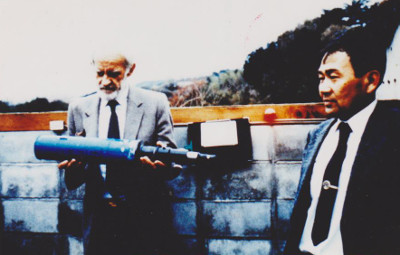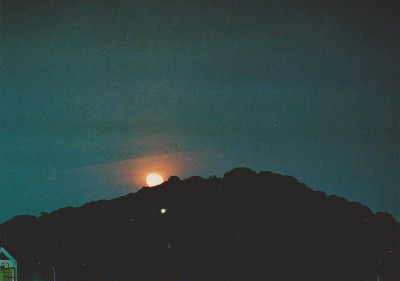April 21, 2021
The 50th Comet Conference at Kochi is indefinitely postponed
June last year, the Comet Conference to be held at Kochi
was postponed unfortunately due to the widespread new corona virus infections.
This conference was its 50th meeting, a significant milestone to be celebrated.
This year a fifth wave of the virus has been unexpectedly
persistent and the organizers came to the conclusion that the conference
inviting participants from far and wide should be avoided. Thus, the Kochi
conference was postponed again indefinitely.
The history of the Comet Conference goes back to August 1954
when the first conference took place at Yamamoto Observatory near Kusatsu,
Shiga prefecture, following the proposal from former Kyoto University professor
Dr. Issei Yamamoto. I was an inexperienced 23-year-old, but invited to
attend. It turned out to be a great gathering beyond our expectations,
with more than 30 scholars and students of the study of the comet attending.
Soon afterwards the number of comet hunters searching for comets had surged
in Japan. This was a successful result of continuing learning opportunities
provided at the conferences.
The Comet Conference initiated by Dr. Yamamoto had been held
three times to 1955. Although there was a period of about 15 years without
any meetings, a new Comet Conference in the present format was initiated
by Dr. Ichiro Hasegawa, Mr. Nobuhisa Kojima, and me of the post-Yamamoto
Oriental Astronomical Association. The inaugural conference was held at
Gamagori in Aichi prefecture followed by the second conference at the famous
Katsurahama beach, Kochi city. What prompted the the new Comet Conference
of 1971 was a photographic discovery of a faint comet by Mr. Hisanobu Kojima,
the first by an amateur astronomer. Following this, discoveries and observations
of comets by amateur astronomers have increased dramatically with extensive
use of photographic techniques.
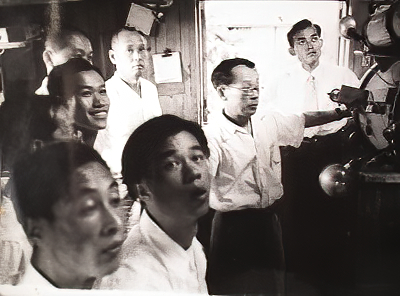
A scene from the Comet Conference at Yamamoto Observatory in August 1954
"Tatsukushi" has become a star
A minor planet discovered at Geisei Observatory was
named after "Tatsukushi", a beach near Cape Ashizuri in the western
part of Kochi prefecture. It is (12335)Tatsukushi=1992 WJ3. It has an impressive
sight of the huge rock pillars of unusual shapes thrusted upward above
the beautiful water of Ashizuri. You can also observe colorful tropical
fish inhabiting the water in the region through the glassed viewing windows.
I visited Tatsukushi for the first time in 30 years and was deeply impressed
once again. I had a privilege of recreating its superb view as a shining
star in space.
In 1986 a public viewing event for Halley's Comet was
held on a beach near Tatsukushi. I vividly remember the comet which moved
people immensely and faded into eternity over the blue ocean. While I was
staring at the distant horizon, a poem written by my late friend crossed
my mind:
Comets
Comets are travelers, travelling a brief moment of
their eternal journey
Everything swam along with the comet into the infinity
of the blue ocean
Leaving behind only broken seashells on the shore
Tatsukushi is a beach on the western side of Ashizuri
peninsular in Kochi prefecture known for an unusual sight of rock pillars
of various sizes sculpted by waves. An undersea viewing tower is built
there to see many kinds of rare fishes.

Tatsukushi beach
Strange visitors to the observatory
When summer brings humid weather, horror stories become a
predominant entertainment. It is nothing unusual to hear about monstrous
creatures appearing around the observatory, but real frightening creatures,
not like imaginary ones in stories, actually visit the observatory occasionally.
About 20 years ago, I witnessed a bear while observing at
Geisei. Quite recently, bears have appeared in the neighboring Aiki city
and it has become a popular topic in the newspapers. As Geisei is more
remote, there is nothing unusual about bears wandering around. When I come
to the observatory, I always see a pair of large eyes shining in the gKemono
michi no morih (the forest of gthe pathway of beastsh) in the east. This
is truly the master of the forest, but it is not known what it actually
is. I know the eyes of dogs and cats shine at night, but the eyes I see
are far larger than theirs.
One of our relatives visited us today. She was an elementary
school student and came over to the observatory to watch the stars for
her school homework. Unfortunately, it was mostly cloudy and we barely
managed to see the moon past the first quarter. We left the observatory
early and walked down to the parking lot 100 meters away. On our way there
we came across a group of mysterious animals. They blocked our path completely.
gBears!h, I thought. A little apprehensive, I turned my flash light to
them timidly and found that they were a family of wild boars trying to
cross the road. The parents were at the head followed by two others with
a numerous piglets toddling between them. A single wild boar is seen occasionally,
but I have never seen so many of them together.
About 10 years ago, I saw a family of Japanese serow (goat
antelope) moving toward the valley. After all, Geisei is really out in
the gboondocksh. Animals like these seem to inhabit the forests around
Geisei. I may explore the area in the near future. While observing at night,
I hear eerie howls of mysterious animals in the valley.

A family of wild boars crossing the road from the observatory
Photographed by Mr. Noriyuki Shimizu
The return of Comet Ikeya-Murakami
The comet visually discovered in 2010 in Japan has returned.
It is at the 19th magnitude now and we at Geisei Observatory have made
observations too. The nucleus is now split into A and B, nucleus B being
reported to be the main nucleus. The photograph below was taken with Geiseifs
70cm reflector and the image was processed by Mr. Shigeo Shimomoto. Look
closely at the short curved tail. The comet seems to reach only the 18th
magnitude even at its maximum brightness. It is a difficult target for
amateurs astronomers.
However, this comet was discovered visually in 2010 by Mr.
Ikeya Kaoru of Shizuoka prefecture and Mr. Shigeki Murakami of Niigata
prefecture. Does this mean the comet was brighter than its standard brightness
at the time of discovery ? Mr. Ikeya discovered it with a 25cm reflector
and Mr. Murakami with a 46cm Dobsonian telescope. It was found to be a
short period comet with roughly a 5-year orbital period. The recovery of
this comet was made at its first memorable return.
I met Mr. Murakami, a co-discoverer of this comet, at the
Comet Conference held in Niigata prefecture in 2007. He brought along the
46cm primary mirror in a bag to the conference venue. He loads his car
with his telescope and altazimuth mount when he goes out for observing.
At the observing site, he assembles the telescope and starts observation.
In the evening he searches the western sky. On moonless dark nights, he
searches the pre-dawn eastern sky too after spending the night in his car.
There have been many gmobileh comet hunters in the past.
Lewis Swift, an American comet discoverer, succeeded in finding 13 new
comets and many galaxies. For his observing site, he chose the rooftop
of a factory building, about 1km away from his home. To reach his observing
spot on the roof, he had to climb three levels of stairs. On cold winter
mornings, the roof tiles were frozen and he had to crawl to move on the
roof. He didnft use any heating device at all in below-freezing temperatures.
At the dawn his body was chilled to the bone. His glorious achievements
were built upon such tremendous efforts.
Periodic Comet Swift-Tuttle with an orbital period of 130
years is the parent of the Perseid meteoroid stream.
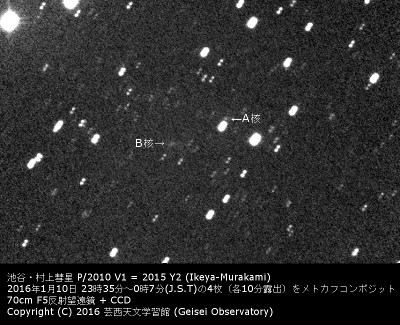
P/2010 V1 = 2015 Y2 (Ikeya-Murakami)
Comet Ikeya-Murakami 2010 V1 = 2015 Y2 (Ikeya-Murakami)
January 10, 2016 23:35-0:07 (J.S.T. )
Composite of 4x10-minute exposure
70cm f/5 reflector with CCD
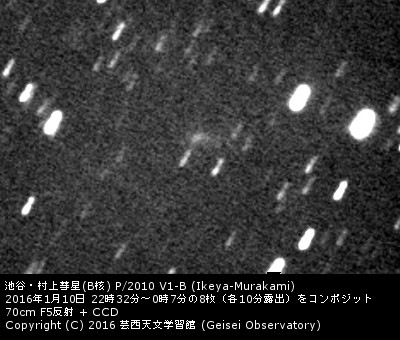
P/2010 V1-B
Comet Ikeya - Murakami (B) P/2010 V1-B (Ikeya-Murakami)
January 10, 2016 22:32-0:07 (J.S.T.)
Composite of 8x10-minute exposure
70cm f/5 reflector with CCD
Refurbishment of Geisei Observatory's 70 reflector
The 70cm reflector at Kochi Prefecture's Gisei Observatory
has been refurbished. This telescope had a focal ratio of 10 but was equipped
with a simple reducer to make it work at f/7 for imaging. Recently, the
company which had built this telescope has replaced it with a 5-element
high quality reducer. This improvement resulted in a combined focal length
of 3500mm (f/5).
On the night of December 8, test imaging was done by the
Geisei observing team. We captured a magnificent, impressive appearance
of C/2013 XI (PANSTARRS) among others. This photograph processed by Mr.
Shimomoto shows a splendid image of this comet caught between two bright
stars of 7th and 8th magnitudes horizontally placed. The comet will become
increasingly brighter and larger as it nears April 2016 perihelion.
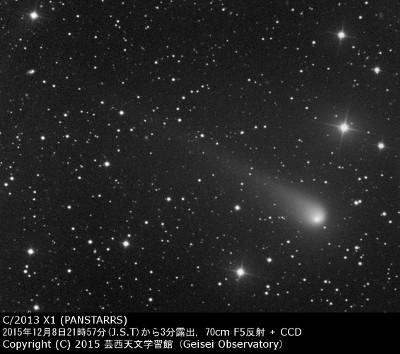
C/2013 X1 (PANSTARRS)
3-minute exposure at 21:57, December 8, 2015 (J.S.T.)
70cm f/5 reflector and CCD
The annual conference of the Oriental Astronomical Association at Matsuyama
The annual conference of the Oriental Astronomical Association
(OAA) was held at Ehime University on September 5 and 6. The OAA is an
astronomical association with its long history beginning in Taisho period
(1912-1926) with many active members.
On the first day of the conference there was a commemorative
lecture by Professor Yoshiaki Taniguchi of Ehime University. On the second
day, a lecture was given by Professor Hiroki Kosai, a former staff member
of the National Astronomical Observatory of Japan. There was also the presentation
of research papers by the association members.
Professor Kosai was working in the observatory's astronomical
object search section at the time of the peak of visual discoveries in
Japan and incoming telephone and telegram reports were handled by him.
I think his work was made difficult by incredibly erroneous discovery reports.
I fondly remember his visit to Kochi prefecture about 40 years ago and
our "exploration" of Ryugado Cave. Currently Professor Kosai
is the director of Saji Astronomical Observatory in Tottori prefecture.
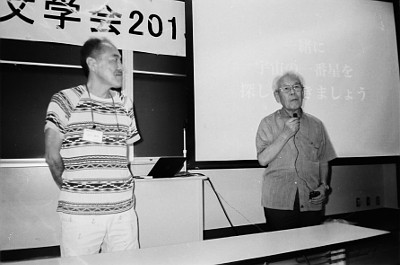
Prof. Taniguchi (left) and Prof. Kosai (right)
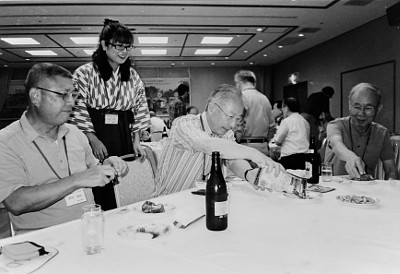
Members enjoying the reunion
Mystery on August 16
A strange incident occurred on the day following the end
of the Pacific War of August 15, 1945. During the war, there was a military
base of Tokkotai (lit. special attack force, known as "Kamikaze")
on the beautiful beach called "Sumiyoshi"on my way to Geisei
Observatory from my home in Kochi city. This unit was named gShin-yo taih
(lit. ocean-shaking force). Although it was called Tokkotai, it didnft
involve airplanes, but two-man crew small ships carrying bombs to attack
enemy warships. It is thought that there were many such bases across the
country. On the evening of August 16, 1945, when the war was supposed to
have ended, a mysterious telegram was delivered to the base. It read "the
119th Shin-yo tai, immediately leave the base for a sortie". The headquarters
of Shin-yo tai for Kochi prefecture was located at present Suzaki city.
This mysterious telegram was probably sent from there. The soldiers on
the base believed the message and began preparation for the sortie. About
200 of them started moving the bombs from the storage hidden in woods along
the beach down to 22 waiting ships. For an unknown cause, one of the bombs
exploded violently and the 22 ships blew up one after another killing 111
soldiers. One of the most beautiful blue beach in Kochi prefecture instantly
turned into a dreadful hell of blood. According to witnesses nearby, a
number of soldiers were seen flying high in the sky like kites.
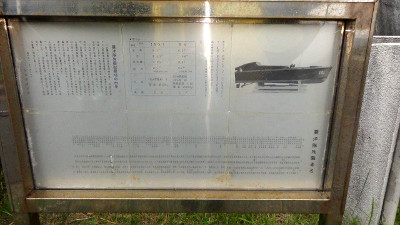
The Shin-yo tai memorial
It was about 10 years ago when I visited the site of this
incident for the first time. It was in the evening twilight. In the woods
there was an abandoned badly damaged vehicle painted in army khaki, which
might have transported bombs. The darkening sea was calm. Blue waves were
washing onto the white sandy beach as if nothing had happened. When I was
just about to return, I felt something trying to pull me back. It could
be the spirits of the dead soldiers. Many soldiers must have come from
outside Kochi prefecture. They must have wished to go home. I faced the
beach and quietly put my hands together in prayer toward the direction
where the roaring of the sea was heard in twilight.
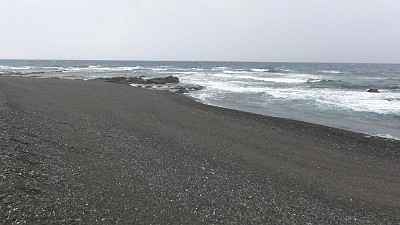
The beach at Sumiyoshi
About Pluto
NASA's unmanned space probe is approaching the dwarf planet Pluto. As Pluto was discovered in 1930, the year I was born, I have a special affinity to Pluto.
As it was in Sagittarius at the time of the discovery, I
realized it would be still in Sagittarius and attempted to photograph it
with Geisei Observatory's 70cm reflector. Mr. Shigeo Shimomoto of the observatory
checked the photograph and found Pluto captured as a 14th magnitude star
(as marked by the arrow) among the numerous faint stars of the Milky Way.
About one hour later, I took another shot, but its motion is difficult
to detect by comparing the two photos because of Pluto's great distance.
However, by displaying each photo alternately, it will become easy to see
the motion. (See the third photo.) This observing was made on the second
day after I was discharged from the hospital where I had an operation for
my ongoing heart problem. It may have been a little reckless, I regret.
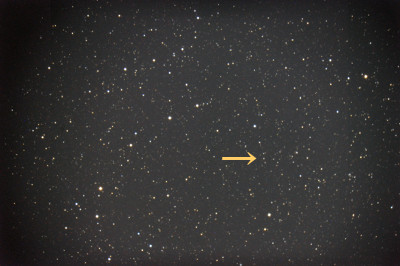
Pluto
12 midnight on July 15, 2015
70cm f/7 reflector at Geisei Observatory with Nikon D700
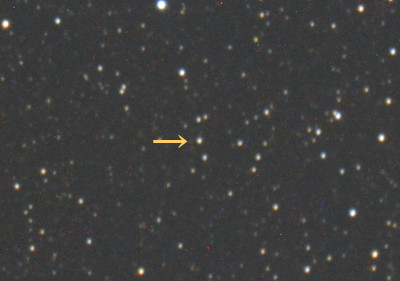
Pluto and its vicinity enlarged
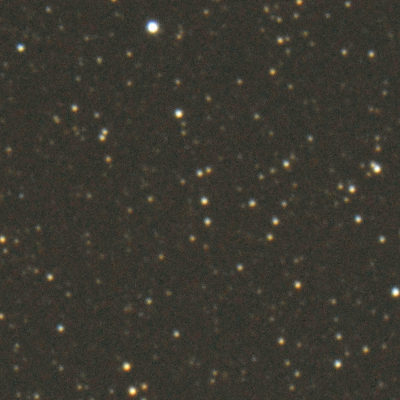
Animation using an image taken one hour later
(Pluto is the object shifting its positions at the center)
In the 1970s, a BBC program producer came to my place for
the filming about Clyde Tombaugh, who discovered Pluto in 1930. He visited
the world's famous observatories for the production of "The Wonders
of the Universe". Geisei Observatory did not exist at that time. The
whole episode was published as a book by an English writer. I have a copy
of the book.
Pluto was discovered in 1930 by Clyde Tombaugh during the
search for the 9th planet overseen by the observatory's second director,
V.M. Slipher. The search was initiated by the first director, Percival
Lowell, famous for his Martian canal theory. Pluto caught the world's attention
as a new planet which orbits outside Neptune's orbit. When the BBC producer
met with Clyde Tombaugh at Lowell Observatory, Mr. Tombaugh told him about
the discovery of Pluto and casually referred to mysterious flying objects
as the only astronomer who believed in UFOs. Mr. Tombaugh said the UFOs
often circled over his observatory in the desert, but the producer wasn't
quite sure if he was serious or just joking.
The BBC's program was not broadcast in Japan, but the late
Dr. Brian Marsden saw the program and told me that he would like to visit
Kochi someday. His visit took place in 1987, the year following the departure
of Halley's Comet.
July 5, 2015From the windows of a hospital room
I am hospitalized at the Red Cross Hospital in Kochi city
with a heart problem. I am expected to be discharged about 10 days after
the operation. Since my younger days, I have been engaged in astronomical
observing without any illness and this is likely to become a special period
of time in my life.
I can see a series of mountains in the north from my room
on the 6th floor of the hospital, which is located on the northeastern
side of the city. Right behind these low mountains lies the Shikoku Mountain
Range.
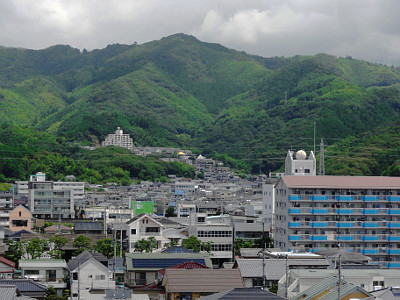
Looking north from my hospital room
The mountain (the Shorenji plateau) seen due north is at
an elevation of 350 to 400 meters, where the first golf course in Kochi
prefecture was built. In September 1965, when I was chasing Comet Ikeya-Seki,
it was this mountain where I finally found myself face to face with the
comet in its entirety in the dawn sky after it had safely made a close
approach to the sun. I fondly remember a curved white tail hanging over
the clouds and trees. September this year, it will be the 50th year since
the discovery of Comet Ikeya-Seki.
When looking at the beautiful nightscape in the distance,
I remembered the image of the comet over the lights of Nangoku city. The
discovery of this comet led to friendship with many people in the world.
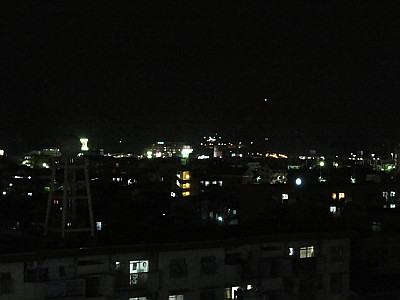
The nightscape from my hospital bed
On my calling card, the photo of the comet passing through
the sun's corona is printed. Looking at this small photo, people will get
to know me better than any other way. Today, many faint comets are discovered
by professional observatories searches, but there is nothing more exciting
than visual discoveries of comets.
May the dream of discovery come true one more time!
June 30, 2015About the Pons-Winnecke meteor shower
In the previous diary, I talked about witnessing a Pons-Winnecke
meteor shower fireball. This meteor shower seems to have appeared often
in the past. Pons-Winnecke is the name of a comet (7P/Pons-Winnecke).
In June 1927, Dr. Issei Yamamoto of Kyoto University traveled
to then Manchukuo to observe Comet Pons-Winnecke because it was during
the rainy season in Japan. In the city of Mukden (present Shenyang, China),
he set up a 10cm refractor on an equatorial mounting and was observing.
Suddenly, a flash of light brightened the area. It was as bright as daylight
for a few moments. "Who did it!", Dr. Yamamoto looked around
believing someone used a photographic flash. He didn't find anybody around
him. Looking up at the sky, he saw a long bright meteor trail stretching
across the sky. Clearly it was a fireball. Later, when he developed a photographic
plate, he found a magnificent meteor of negative magnitude. It was obviously
a meteor from the Pons-Winnecke meteor shower at its prime. This photo
had been on display for a long time at his observatory. I saw this photo
for the first time when a comet conference, the first of this kind in Japan,
was held at Yamamoto Observatory in Shiga prefecture in August 1954.
This meteor shower was very active in 1927 and many observers
were on the alert in June the following year, expecting many meteors would
appear. However, the result was negative. Mr. Kaname Nakamura, assistant
at Kyoto University, was the only observer who reported many meteors. The
question arose why Mr. Nakamura alone saw so meteors, while many other
observers didn't see even a single meteor.
Dr. Yamamoto concluded that these meteors had been so faint that only sharp-eyed Mr. Nakamura had been able to see. He wrote this in some publications.
In June 1998, I encountered the magnificent return of this
meteor shower, the first since the last appearance 71 years ago. Surely,
many of the meteors were faint and characteristically so slow as can be
mistaken for artificial satellites. However, there were many fireballs
brighter than the first magnitude and I had some doubt about the reasoning
that "these meteors had been so faint that only Mr. Nakamura had been
able to see".
June 28, 2015
A fireball from the Pons-Winnecke meteor shower
The Pons-Winnecke meteor shower is a rare and nostalgic name.
It may be called the June Bootids today. At 1 am on June 22, when I was
looking at the sky, suddenly a fireball streaked from Bootes across the
northeastern sky. It appeared as an orange-colored ball at -1 magnitude.
It was very slow, so slow in fact it could be mistaken for an airplane
and blazing for about 4 seconds.
Twenty years or so have passed since we encountered the meteor
shower that hadn't been known then on the day of public viewing at Geisei
Observatory. This news circulated across the world by the internet. Mr.
Yabu, a specialist in meteors, is reported to have said it was an unknown
meteor shower. Simultaneously three faint meteors flew extremely slowly
in Cygnus, followed by a fireball, which lit up the surroundings. This
meteoric shower had ceased for 100 long years and had been forgotten. My
photographs of many fireballs that night were published in the OAAfs journal
"The Heavens".
The fireball I saw on June 22 may be the precious glow of
the sole meteor of the now ceased meteor shower.
March 21, 2015
50 years from the discovery of Comet Ikeya-Seki
At last, long awaited spring weather has arrived with the
passing of the first day of spring on the solar calendar. However, "cherry
blossom viewing parties" are not seen yet at Sakuragaoka where Geisei
Observatory stands. The 50th anniversary of the discovery of Comet Ikeya-Seki
falls upon this year. In Kochi prefecture no particular event is planned
in association with the discovery, but in the neighboring Ehime prefecture,
lectures are planned to commemorate the occasion. As soon as it is confirmed,
the information will be provided on the "General Notice Board"
page of my website.
Although this event in Ehime prefecture was probably not
in the organizers's mind, the Tsutomu Seki exhibition and astronomy lectures
were also held in February at Kochi City Children's Library. In display
were medals awarded to me as well as my observing equipment, star charts,
and field notes belonging to me who has devoted half a century to the study
of astronomy. During the event, I gave a public lecture on astronomy. At
the venue of this event, my "laundry-drying platform observatory"
was recreated, which I had used in the era when I discovered Comet Ikeya-Seki.
This was the idea of Mr. Kimihiro Matsuki, instructor at Geisei Observatory,
and others. I gave my lecture standing on that platform. This platform
was built, I heard, as DIY by a staff member of the Children's Library,
who was good at woodwork. As soon as I walked onto this platform, I remembered
the night of my discovery of Comet Ikeya-Seki. I was hearing the sound
of waves pounding Katsurahama beach 10 km away generated by an approaching
typhoon. In the midst of this, the comet appeared, which I discovered with
a wooden white square-tubed comet seeker, whose replica was standing before
my eyes. Before I knew it, I was holding the telescope firmly and quietly
searching. My discovery of the comet that night was not seen by anybody,
but now how I discovered it happened to be seen by many people for the
first time after 50 years.
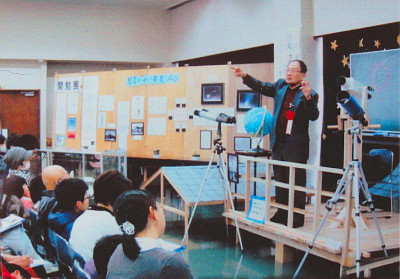
Tsutomu Seki, giving a talk on the
reconstructed "laundry platform observatory"
In the audience there were many children, but serious astronomy
enthusiasts and amateur astronomers were also there. I found Mr. Takeo
and others who came all the way from Ehime prefecture. Surprisingly, I
saw the face of a former comet hunter at the back who had unfortunately
missed the chance of discovery even though he was searching that night.
The memorable 9cm comet seeker is to be donated to a new
science museum to be soon built in Kochi city. The 60cm reflector which
had been used for observation at Geisei for many decades and discovered
many minor planets is to be gifted to a university in Lebanon in the Middle
East.
February 6, 2015
My memories of Comet Seki-Lines
This is February 4, traditionally the first day of spring
in Japan, based on the Solar calendar. The first day of spring reminds
me of the discovery of Comet Seki-Lines. In those days, I would come home
from the music class at Harimaya-bashi bridge, which was my workplace,
late at night taking a streetcar from there, getting off at Kamimachi 1-chome
(where Ryoma Sakamoto was born), and then walking for 300 meters to home.
Over Washiosan Mountain in the south, Sirius of Canis Major
was flickering furiously shaken by turbulent winter air while the majestic
Milky Way was bearing down so close overhead. In the sky over Kochi city
in those days, the beauty of the constellations were still preserved.
As soon as I walked through the gate, without saying "I'm
home", I climbed to the rooftop laundry drying platform in the courtyard,
which served as my observing site. I began searching through the Milky
Way lying low in the southern sky, holding fast my home-built 9cm comet-seeker
set up in the middle of the platform. Nearly midnight at half past 23 hours,
I found an unusual object in the extremely low sky at -38 degrees in declination.
It was the discovery of Comet Seki-Lines, which grew larger and passed
perihelion on April 1. It was a discovery made "without any ambition"
for discovery.
This "laundry-drying-platform-cum-observing-site"
was also the place where I discovered Comet Ikeya-Seki later. Yesterday,
I climbed to this observing site, which was supposed to have been dismantled
a long time ago. There I found a white square-tubed comet-seeker, which
I last saw 50 years ago! Without thinking, I grabbed the comet-seekerfs
handle and began searching. Was I dreaming? No, it was real undoubtedly.
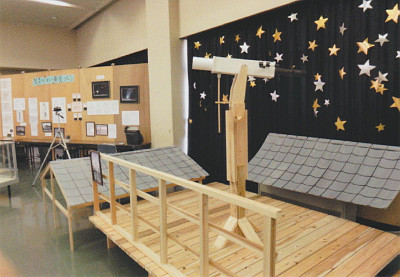
The reconstructed laundry-drying-platform
serving as my observing site
My observing platform was faithfully reconstructed at Kochi
City Children's Science Library. A ceremony to celebrate the transfer of
my long used 9cm comet-seeker to Kochi city was held in the presence of
Mayor, director of the city's board of education, as well as director of
the committee of culture and education, which administers Geisei Observatory
in Geisei village.
At the venue, as many as 80 items are in display including
astrophotographs, medals awarded for my discoveries, and other items related
to me. Also being displayed was a panel to show the confirmed numbers of
the 223 minor planets discovered and subsequently named by Geisei together
with the diagrams of their orbits. It is a prominent display and I appreciate
the tremendous amount of work they have put in to realize this exhibition.
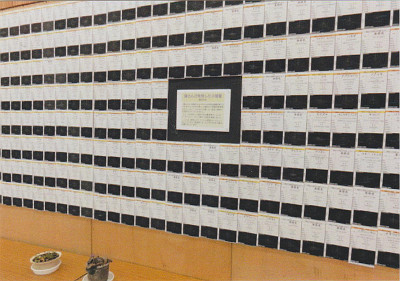
The display panel for the 223 minor planets
discovered and named by Geisei
It will take at least one to several years after the discovery
of a minor planet before the confirmation number is given by the Minor
Planet Center. Many of them were observed again at Geisei Observatory at
their following returns. It was terrifying even to think how long it took
for all the 223 minor planets to be confirmed.
On February 8, I will stand on this replica of my observing
platform to give a talk. It will all the more vividly bring back the memory
of the night when Comet Ikeya-Seki appeared.
January 21, 2015Memorable Comet Finlay
Periodic Comet Finlay is now bright in the evening sky. By
our observation at Geisei Observatory in the evening of January 19, it
was at 9.5 magnitude (photographically 10.1). It was a little east of Mars
and the favorable observing conditions will continue for some time. However,
as it passed perihelion on December 27, it is very unlikely that it brightens
further.
15P/Finlay was discovered for the first time as far back
as in 1886 by William H. Finlay, a comet hunter at Cape (South Africa).
The comet seen in his 175mm refractor appeared stellar at 11th magnitude
with a slight coma. Its orbital period is 6-and-a-half years and at its
next apparition in 1893 Finlay himself found it visually using the same
telescope. Recently, it has been often talked about because of its outbursts,
but this comet is intrinsically a visually observable bright comet.
I called this comet a "memorable" one, because
a Japanese observer found this comet at its 1919 apparition. That year,
the ephemeris of the comet was not available. A young astronomer Mr. Tetsuo
Sasaki working as an assistant at Kyoto University observatory discovered
the comet while searching with a 10cm refractor. The discovery was verified
by Dr. Issei Yamamoto of the same university and telegraphed to the Tokyo
Astronomical Observatory, the Copenhagen Observatory, and the Harvard College
Observatory. Looking at this telegraph, Mr. Shigeru Kanda, a technical
officer at the Tokyo Astronomical Observatory, announced that this comet
was a return of Comet Finlay.
At its return in 1974, I succeeded in recovering this comet
using a 21cm reflector at newly built Seki Observatory (present Geisei
Observatory). The photograph below shows Comet Finlay with a tail shining
low in the evening sky.

15P/Finlay
At 18:26, January 19, 2015
70cm f/7 reflector and Nikon D700 at ISO 2000
42-second exposure
Related article:
Memorable Comet, Comet Finlay
January 1, 2015
A Happy New Year
I wish you all a happy New Year. Below are the photographs
of Comet C/2014 Q2 taken on December 30 and Geisei Observatory's 70cm
telescope tracking this comet. I used ISO 1600 film and automatic tracking
for a 10-minute exposure was accurate. The comet was at 5th magnitude,
bright enough to be visible to the naked-eye, trailing a 3-degree-long
straight tail of Type I to the north.
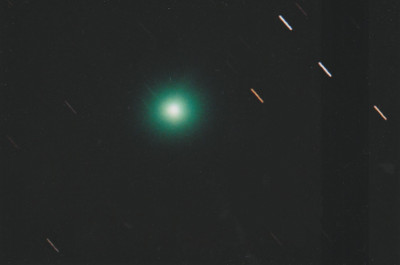
C/2014 Q2 (Lovejoy)
10-miniute exposure with ISO 1600 film

The 70cm telescope and Orion
A photograph of Comet Jacques
We continue to experience hot days. In the heavens above,
it is the time when the Milky Way is at its best and most beautiful. C/2014
E2 (Jacques) has been observed in the southern sky since this spring and
was expected to become brighter. Now this comet has become visible in the
predawn sky. It is at 6th magnitude and difficult to the naked eye, but
visible in 7x50 binoculars.
The photograph below was taken by a 2-minute exposure using
a Nikon DSLR (D-700) mounted on Geisei's 70cm reflector. The tail trails
due west, but is not clearly seen in the photograph. You will be able to
enjoy the comet low in the predawn eastern sky for some time to come.
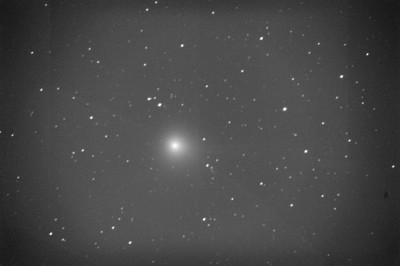
C/2014 E2 (Jacques)
3:20-3:22, July 26, 2014 (J.S.T.)
70cm f/7 reflector with Nikon D700
Copyright (C) 2014 Geisei Observatory
The eye that can find a comet
June 2nd (UT) was the day when Comet Honda-Bernasconi C/1948
L1 was discovered. Mr. Minoru Honda was living in Setomura, Hiroshima prefecture,
at that time. On November 15, 1947, soon after repatriating from the southern
battle fields, he discovered Comet Honda C/1947 V1. In June the following
year, he quickly discovered a new bright comet in a summer sky. On the
morning of June 3rd, after completing routine search with his 15cm reflector,
he was looking leisurely at a brightening northeastern sky with the naked-eye
as dawn broke and unexpectedly spotted in Perseus a diffuse comet-like
object trailing a faint tail. It was reported to be at fourth magnitude.
In today's skies, it would probably be very difficult to
discover this comet visually. It was only three years after the end of
the war and even in Kochi city where I lived, the skies over the city of
200,000 residents were dark. The vicinity of Harimayabashi Bridge was also
dark, though the area was the brightest part of the city. In fact it was
so dark that the Andromeda Galaxy could be observed with the naked-eye.
I could imagine what the starry skies would have been like over Setomura
village deep in the mountains
Mr. Honda was deeply in love with mirrors ground by Mr. Kibe
and used a 15cm f/6.3 Kibe mirror with a Goto Optics 40mm Kellner eyepiece.
The lowest effective magnification was 24. The field of width was only
1.5 degrees. This eyepiece, which discovered many comets, is currently
in my possession. In 1950, he moved to Kurashiki city and began to use
a 10cm binocular telescope. Thus, the Kellner eyepiece used for his 15cm
reflector was given to me, his first protege.
When I am looking into this 40mm eyepiece, I feel reliving
his excitement of comet discovery. Mr. Honda would intensely look into
this eyepiece with his "comet-spotting" special eye. In the future
I would like to talk about this "special eye" I learned from
Mr. Honda. This eyepiece and "special eye" gave birth to Comet
Seki 1961 T1 later.
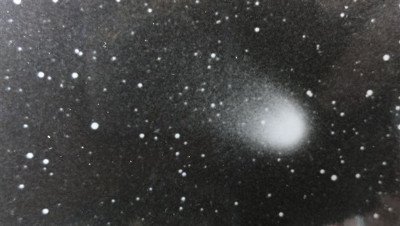
C/1948 L1(Honda-Bernasconi)
June 10, 1948
Courtesy Skalnate-Pleso Observatory
Concierto de Aranjuez
More than two months have passed since the guitarist Mr.
Minoru Inagaki passed away. I felt particularly close to him as I gave
him Minor Planet Inagaki as a gift. I was interviewed by Tokyo Asahi Shinbun
Newspapers about the naming of this minor planet for an eulogy for him.
I believe the beauty of guitar music is found in the classics.
While many young guitarists play nothing but contemporary music, Mr. Inagaki
was an orthodox guitarist who played a wide range of music from classical
to romantic as well as modern. His premature death is a huge loss to us.
His performance I last attended was about 20 years ago. It
was at Tokuyama city and the sound of his exquisite instrument Fleta still
lingers deep in my ears. Mr. Inagaki, who has departed on a journey into
space, will surely play beautiful music for us from the world of the stars.
Mr. Inagaki's teacher was Mr. Toshiaki Kondo of Osaka. Mr.
Kondo's older brother Tsuneo was a composer, whom I have met many times.
He published a monthly gGuitar Geijutsuh (the art of guitar). It was around
1955, I guess, when Joaquin Rodrigofs Concierto de Aranjuez for guitar
was first performed in Spain, Mr. Inagaki came to see me with the recorded
audiotape of that performance. He told me he had obtained it so quickly
thanks to the kindness of the Spanish Embassy. This piece was recorded
with a solo by de la Maza accompanied by a Spanish orchestra. The fact
that this piece was introduced to the world several years later by phonograph
records means that we were lucky enough to be able to enjoy the music right
after it was born. Immediately, it was introduced at one of the regular
record concerts held at Kochi City Community Hall. In Adajio in the second
movement of this music, it was a pleasant surprise that the orchestra played
the role of solo accompanied by guitar, reversing their usual roles. Master
guitarist Narciso Yepes played it as one of his specialties.
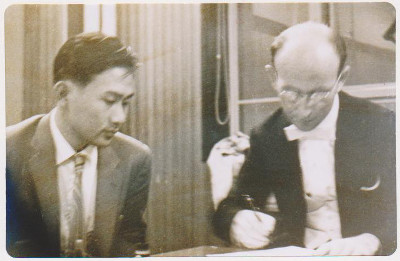
With Narciso Yepes at Osaka for his first visit to Japan around 1960
Wishing early recovery
The photograph below shows a sheet of stamps placed on an
envelope. These were issued around 1986 in the U.K. to commemorate the
arrival of Halley's Comet. It was sent to me by the mother of a young man
who became bed-ridden due to a car accident.
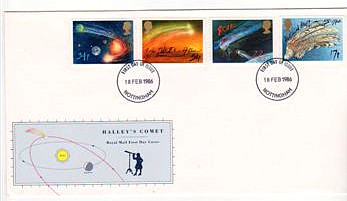
A sheet of stamps on an envelope
She asked me for my autograph. She told me she had already
received the autograph of William Bradfield, Australia's comet hero. The
father of this young man was an well-established astronomer graduated from
a university in America. He was studying astronomy following in his father's
footsteps, when the accident happened. It was a very unfortunate incident
for him. I have no doubt that his mother, wanting to lift his spirits,
asked a person like me for an autograph. I will return the sheet with my
signature as soon as possible. I pray for his quick recovery.
I remember the image of Halley's Comet seen from New Caledonia
in 1986, shining near the Southern Cross. I also remember about the observations
of this comet from Geisei Observatory. I recall many dramas associated
with Halley's Comet.
Mr. William Bradfield inspects my comet seeker which has
discovered a number of comets including Ikeya-Seki at Seki's observatory,
Geisei village
(March 1991)
July 4, 2013
The stars of the Star Festival
My first encounter with "the stars of the Star Festival"
took place many decades ago, before the daybreak of July 4, 1945. It was
near the end of the Pacific War and at the night of huge air raids of Kochi
city by B-29s. In those days we repeatedly conducted air raid drills to
be prepared for attacks by enemy planes. We built communal underground
air raid shelters in our yards or vacant lots. In 1945, air raids became
very frequent occurring day and night. We spent most of our time in these
shelters.
I was a fun-loving junior high school student at that time
and oblivious to adults' confusion in the midst of adversity. I recorded
the events with my favorite mini camera: an air raid shelter I helped my
father to build in the court yard, air raid drills by many local women,
the streets lying in ashes by huge overnight air raids and so on. These
are valuable records of the time made by my cheap mini camera. Guzzi uses
paper-lined 18-frame 18mm-wide film. It was carried around in my pocket
and always ready for action. It did a great job.
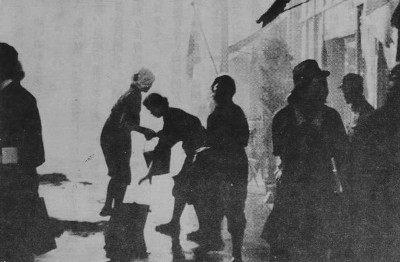
An air raid drill by women and elders,
as young people were drafted to military service.
Before the dawn of July 4, 1945, our family of 6 was in a
bomb shelter. Although air raid warning was issued, I crawled out of the
shelter taking advantage of no sight of enemy planes. When I looked up
in the sky, I found not enemy planes, but a large bluish star shining.
This was my first encounter with Vega (known as the "weaver girl"
of the Star Festival in Asia). The tranquil world of the stars brought
back the memories of my peaceful fun-filled childhood. Soon after, the
roaring sound of airplanes began reverberating ground and sky and air raids
with numerous firebombs started.
During the air raids, 70% of the city was destroyed by fire.
Soon, the war ended, but miseries tended to continue. The Nankaido Great
Earthquake in December the following year caused tsunami destroying the
large part of the downtown area which had escaped air raid fires. The city
was truly disaster-ridden town.
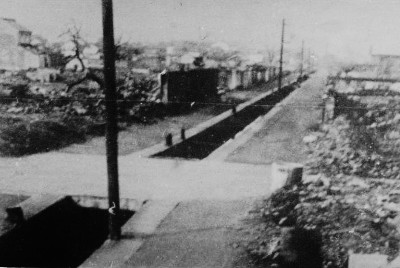
The area around Kamimachi left in complete ruins
by overnight air raids
We used to celebrate the Tanabata Festival (Star Festival)
in the courtyard where our bomb shelter was situated. Colorful paper strips
hanging from two bamboo sticks were flying in night breezes. The festival
was celebrated according to the lunar calendar in those days and it was
toward the end of summer when weather is likely to be good. The stars were
pretty, too.
The festival today takes place in the middle of the rainy
season and there is no atmosphere of festivity like old days.
After the war an observing deck was built at the site of
the bomb shelter and search for new comets began in the era of peace. Comet
Seki (1961 T1) was discovered on the raised ground above the shelter as
seen in the photograph.
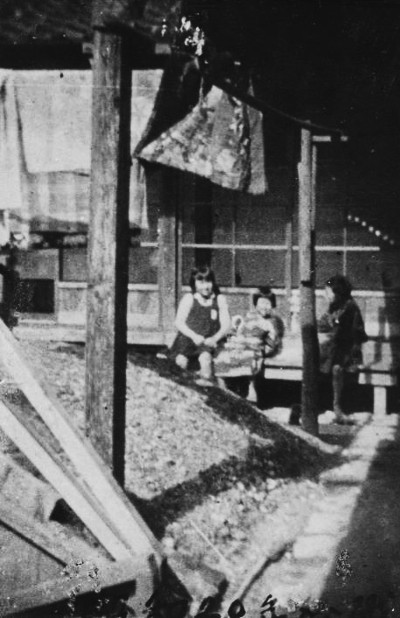
The bomb shelter dug in the courtyard of the Seki residence.
Having the stars and guitar as my friend
This is a photograph of our pet cat "Tritton".
Do you remember that there was a newly discovered short periodic comet
called 157P/Tritton in 2003 Around that time, Ms M in Sendai city was caring
a stray cat, which eventually became her pet. As she was an astronomy enthusiast,
she named it "Tirtton". Comet Tritton, after which the cat
was named, returned in 2009. The cat Tritton has been in good shape since
and waiting for the coming second encounter with the comet. A few years
ago, Ms M experienced the Great Eastern Japan Earthquake. Fortunately,
she escaped its harm and both her and her cat have been doing quite well.
Ms M is very good at guitar. While learning in my guitar
classes, she has become proficient enough to complete all the famous practice
pieces. She watches the stars as a hobby from her home in Sendai city.
She told me she had seen Comet PANSTARRS, which is shining in the northern
sky now. She attended the Comet Conference at Niigata prefecture as one
of the few women participants.
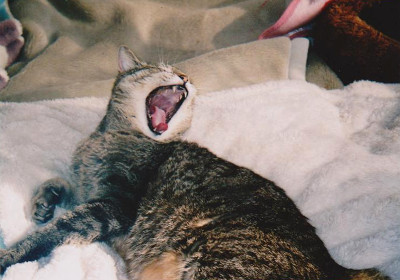
Cat Tritton
Around 1962, I received publicity as "a man who loves
the stars and guitar". After that a number of women who loved the
guitar and stars turned up across Japan, though I don't believe they particularly
followed in my footsteps. Ms M in Kochi city, who was at the same age as
Ms M in Sendai city, had come to my guitar classes for 20 years. She started
with Classical Guitar Method by Carcassi and then even tried Bach's Fugue
and Albeniz's difficult pieces. One day I performed publicly with her.
Albeniz's Torre Bermeja in his Suite Espanola is a masterpiece
in arpeggios style and its tune is still heard deep in my ear. Sadly, Ms.
M succumbed to illness before she reached 50. For many years she treasured
seashells I had collected for her on a beach of Amedee Island of New Caledonia.
It was in 1984, around the time when Halley Comet was shining in the sky.
A related diary entry
Diary October 30, 2003, "Tritton in the sky and Tritton in theroom"
May 19, 2013
The moon over Hitsuzan mountain
Hitsuzan mountain, situated south of the center of Kochi
city, has always been favored by the residents as a place for recreational
activities. The mountain is well known for the ancestral grave of the Yamanouchi
family as well as the grave of Fleet Admiral Osami Nagano, who was called
a war god during the Pacific War. However, it is not so well known as an
excellent location for viewing the moon.
There are many famous places for beautiful moon that have
appeared in songs and poems. Good examples are Moonlight on the Colorado
and the moon over Lushan. The moon over Hitsuzan is no less beautiful and
has its own attractiveness.
In summer evenings, I would sit leisurely in a wicker chair
in the upstairs room cooling myself with a Japanese paper fan in one hand,
while watching the moon over Hitsuzan. It would make me feel relaxed and
calm. As a music lover, I would enjoy watching the moon rising over Hitsuzan,
while listing to Beethoven's Moonlight Sonata on an LP record.
I was 20 years old those days and the discovery of a new
comet was my ultimate goal. I miss those days when I lived single-mindedly
for a noble goal. My eyes and my mind appreciating the beautiful moon were
clear and pure. After 10 years had passed, my sincere prayer to the moon
was finally answered. Having made a successful discovery, I found the moon
over Hitsuzan all the more beautiful and majestic. The same old moon has
appeared over Hitsuzan tonight.
May 7, 2013
Visiting Kurashiki Observatory
I wonder how many times I have visited Kurashiki Observatory.
I surely have made at least 5 visits since Mr. Minoru Honda passed away.
Whenever I visited the observatory, it fell upon the day when the observatory
was closed and unattended. I would leisurely walk in the deserted observatory's
garden and reminisce about the past before leaving.
On this visit, I found the construction going on to extend
the Sumiji Hara and Minoru Honda Memorial Museum. It is expected to be
completed in the second half of July.
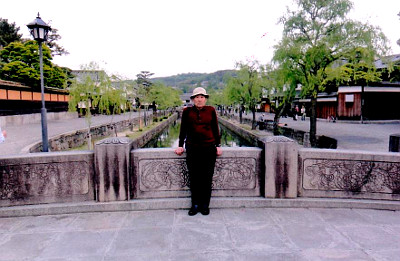
At Curashiki Bikan Historical Quarter
I stood in front of the dome holding binoculars. This is
the spot where Mr. Shigeki Okabayashi discovered a new comet on September
30, 1940. Early in October, Mr. Honda, who was living at Setomura village,
Hiroshima prefecture, at that time, independently discovered this comet
and subsequently it was named Comet Okabayashi-Honda. In the morning of
the discovery, cosmos flowers were in full bloom in the observatory's garden.
At 5 o'clock, the exact time of the discovery, a wake-up siren at a nearby
spinning factory was heard.
In Kurashiki, there used to be extensive facilities of a
spinning company. The area is famous for the streets lined with reddish
brick walls. That night, I stayed at a hotel converted from an old spinning
factory in the Kurashiki Bikan Historical Quarter.
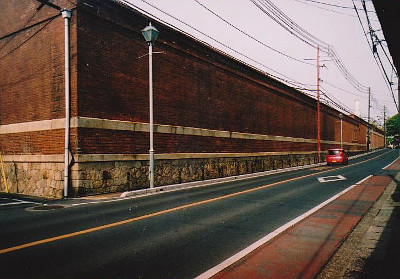
The red-brick walls of a spinning mill
There used to be a spinning mill in Kochi city, too. It occupied
the huge area where the Ion Mall is presently located. It was called Kurashiki
Spinning Company and several thousands employees were working there. A
majority of them were young women coming from all over the country. At
5 o'clock in the morning the mill's siren was heard. My home was about
4 kilometers away from it. On cold winter days, when I finished early morning
observing and looking at predawn skies, the mill's whistle-like siren sounded
and faded quickly. "Even the sound of the siren has frozen!"
Relieved from the freezing cold, so cold I felt like crying, I was returning
to the warm room in the house, then I thought of these women workers who
just got out of bed to start a long working day. I could imagine how harsh
their life would be.
In those days in Japan, tuberculosis, which was even called
Japan's "national disease", was endemic in the dusty air of spinning
mills. Women workers who contracted tuberculosis returned home looking
for a final resting place. My grandfather told me this tragic and pitiful
reality.
Around the time when I successfully discovered new comets
from 1961 to 1962, I remember that I received a letter from a woman who
had contracted leprosy while working at a spinning factory and been spending
her youth in isolation at Oshima Seishoen leprosarium on a remote island
of the Seto Inland Sea. I continued to send her letters of encouragement.
She had spent her youthful days without returning home for 20 years since
she developed the disease. She spent days gazing at the sea while waiting
for my letter to arrive everyday.
The last letter written back to me was from an elderly nurse.
"She was at her deathbed repeating your name quietly...". In
my desk drawer, I keep a seal that she had engraved as a hobby. "I
made this seal praying that Mr. Seki can work for astronomy surrounded
by the stars forever..." It is a large seal with a star in the frame.
I would like to show you this seal someday.
April 25, 2013
"esert Island" Chohei's grave
While I was driving through the area called Kishimoto along
National Highway 55 on the coast, I came across an unusual bronze statue
and old moss-covered gravestone. It seems to have been built recently for
a certain reason. On the nearby signboard was written gThe Statue of Desert
Island Choheih accompanied by a story about Nomura Chohei.
The local fisherman Chohei was struck by a storm while on
his fishing boat about 230 years ago in 1785 and was drifted to Torishima
island 760 km east-southeast. He lived there for 12 long years under extreme
conditions facing starvation. Finally, he managed to build a boat using
driftwood and returned to the shore of his hometown. What an amazing man!
He would become a great hero if it happened today. This occurred
half a century earlier than the time John Manjiro was similarly drifted
from Cape Ashizuri to Torishima island and eventually went to the U.S.A.
Manjiro lived in the U.S. and became famous when he returned to Japan with
the knowledge of American culture. Chohei, however, took a different path
and lived quietly for the rest of his life known as a hero only among the
locals.
In the direction Choheifs statue is gazing spreads an infinite
expanse of blue waters of the Pacific Ocean.
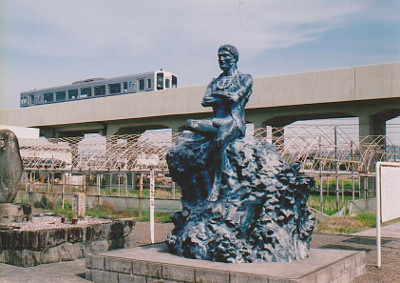
Desert Island Chohefs statue
Comet PanStarrs in the dawn sky
When the comet was in the evening sky, I could hardly observe it, as it
was close to the sun. At last I caught it in the twilight after it moved
to the morning sky. The photograph shows PanStarrs projected by the 70cm
mirror. The comet displays an intensely bright nucleus and a tail over
2 degrees long. The photo captured the comet against fairly bright twilight
around 4:50 on April 4. A visual estimate of the comet?fs brightness is
difficult, but photographically it is about 4.5 magnitude. It will move
northward and become easier to spot, but the brightness will steadily fall.
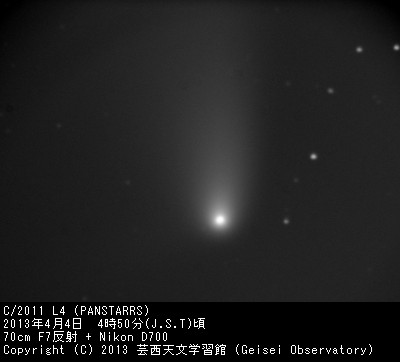
C/2011 L4 (PanStarrs)
Around 4:50, April 4, 2013 (J.S.T.)
70cm F/7 reflector and Nikon D700
Copyright (C) 2013 Geisei Observatory
Comet Iwamoto
This is the first bright comet discovery in Japan since November
2010, when C/2010 V1 (Ikeya-Murakami) was discovered. While searches by
professional observatories are intense, there is still a chance for amateurs
to make discoveries. Photographic magnitudes are reported to be between
12th and 14th magnitude, but visually it is about 12th magnitude with a
small coma and no tail. It has already passed perihelion and will become
fainter, though it appears to be getting closer to the sun.
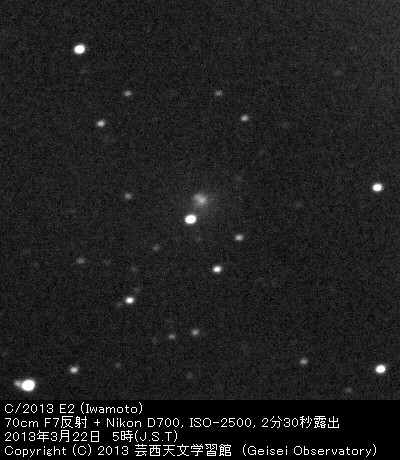
C/2013 E2 (Iwamoto)
2.5-minute exposure at ISO 2500
70cm f/ reflector with Nikon D700
At 5:00, March 22, 2013 (J.S.T.)
Copyright (C)2013 Geisei Observatory
Comet Pons-Gambart
This comet has moved to the morning sky and shines high in
the dawn sky. It has lost the initial brightness it had around the time
of discovery, but a relatively bright nucleus and coma are glowing blue.
When this photograph was taken, its visual magnitude was 12 and photographic
magnitude about 14. It will not be until 180 years later that we can see
it again and I feel a little reluctant to say farewell to this comet.
Many decades ago when the skies were clearer, comet hunters
with keen eyesight were able to discover a comet of this faintness. Peltier
in the U.S. and Denning in the U.K., for example, are said to have been
hawk-eyed comet hunters. There is a chance to discover a retrograde comet
in predawn skies like this if you search with a powerful comet seeker.
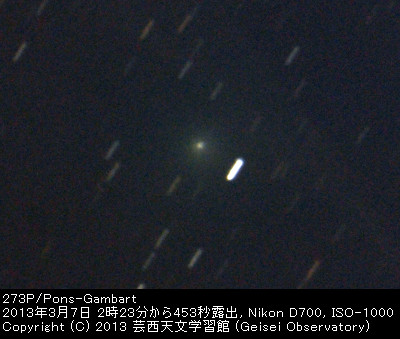
273P/Pons-Gambart
453-second exposure, 2:23 March 7, 2013 (J.S.T.)
Nikon D700 at ISO 1000
Copyright (C) 2013 Geisei Observatory
Comet PANSTARRS
I attempted to capture Comet PANSTARRS nearing perihelion
using 300mm telephoto lens. Through the yellow sand dust in the evening
twilight, I was able to photograph an object which looked like PANSTARRS.
Its magnitude is not clear, but estimated to be 1.5 magnitude. The coma
is about 10?f across. A tail is not seen. It is only a 10-second exposure.
I could not find it with binoculars. The comet is moving northward and
observing conditions will improve day by day.
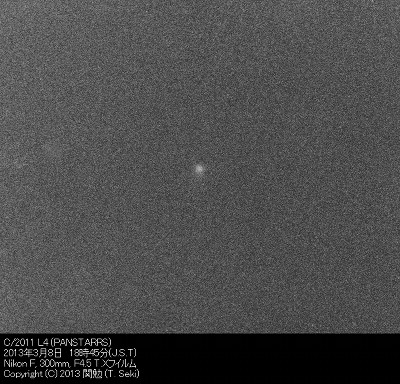
C/2011 L4 (PANSTARRS)
At 18:45 March 8, 2013 (J.S.T.)
Nikon F: 300mm, f/4.5, Tri-X film
Copyright (C) 2013 T. Seki
Photographing 2012 DA14
We had a close encounter with an Apollo group asteroid for
the first time in many years. I attempted to photograph it using Takahashi
ε210 f/3.0 because its motion was so fast. I used ISO 1600
film. As the asteroid motion is large in declination, I moved the telescope
only in declination toward the north at the fixed RA, following the predicted
positions. The exposure time was only 10 seconds, but the tracking was
quite hectic. This photograph was taken around 5 am. Bright galaxies M65
and M66 in Leo are seen. During photographing, I looked through a 70mm-finderscope,
but could not see anything like an asteroid.
In August 2002, about 10 years ago, 2002 NY40 approached
the earth and I photographed it with Geisei 60cm reflector. Because the
motion of this asteroid was much slower, tracking was easier and I was
able to measure the positions as well.
Coincidentally, a meteor hit the earth atmosphere over Chelyanbinsk
in the Ural district of southern Russia and this inevitably fanned excitement
about asteroids. On February 17 a public viewing night was held at Geisei
Observatory and the visitors had a chance to look at a meteorite which
had landed in Russia in 1947. This is known as the Shihote-Alin meteorite.
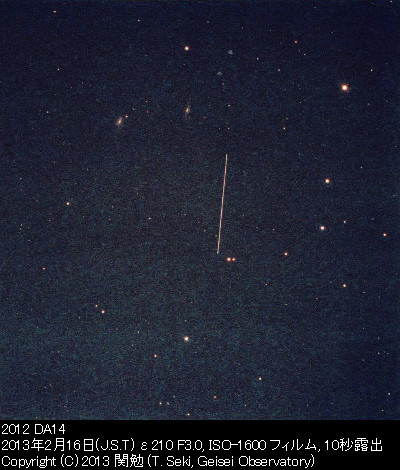
2012 DA14
Photo taken around 5 am on February 16, 2013.
10-second exposure with ε210 f/3.0 and ISO 1600 film.
Copyright (C) 2013 T. Seki, Geisei Observatory

























